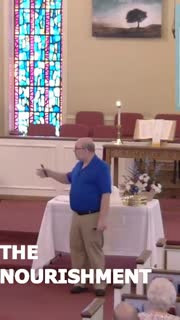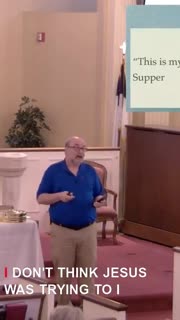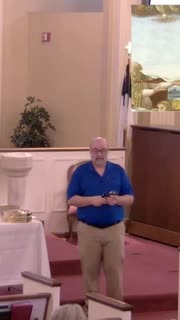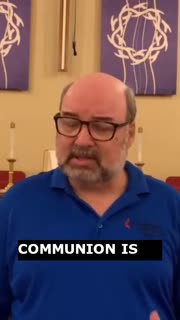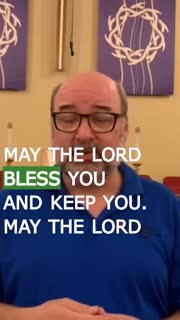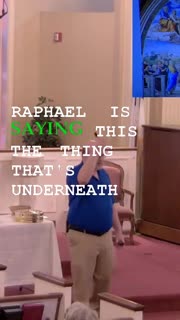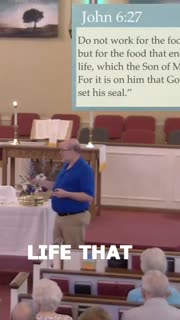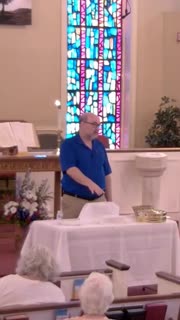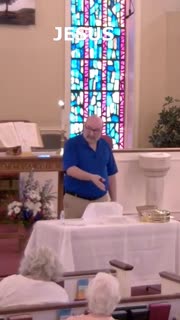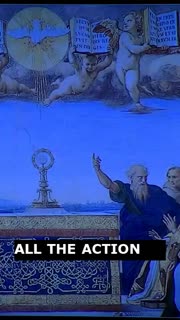The Divine Connection: Understanding the Eucharist
Devotional
Sermon Summary
Bible Study Guide
Sermon Clips
### Quotes for Outreach
1. "The nourishment that God has provided to you indicates as a symbolic of something else, something deeper, something bigger, something more important, and it's been approved by God the Father because the Father set his seal upon his Son and sent his Son to be with us." [51:33] (25 seconds)
2. "I don't think Jesus was trying to... I don't think he wanted us to try to get into the literal meaning of what 'this is my body' means. I think instead it's a message that he gave throughout his entire time teaching. He was always saying, 'This is my body. I'm part of you, you're part of me,' in each part of his teaching." [49:58] (22 seconds)
3. "This is my body, which is broken for you. Take, eat, enjoy it, and know that it is bigger, is more important than anything you've ever seen before. It is the center of the, not only the fresco, the center of our time together, the center of our life, the center of the teachings of Christ." [53:23] (26 seconds)
4. "Communion is such an integral part of our practice of faith. And it's part of that communion is all about presence. It's about the physical stuff, the bread of life, who is Jesus." [56:52] (17 seconds)
5. "May the Lord bless you and keep you. May the Lord make his face to shine upon you and be gracious to you. May the Lord lift up his countenance upon each of you and bring you peace now and forevermore. Amen." [57:38] (11 seconds)
### Quotes for Members
1. "Raphael is saying this: the thing that's underneath this napkin here on our table today, just as it was at the time this painting was created, Jesus is in there. God is in there. This is divine, part of the divinity, part of the presence of God here on earth." [37:19] (26 seconds)
2. "The spiritual life that you're being invited into is bigger, is more powerful. He ends the verse with one of the I am statements from the gospel of John, when he says, 'I am the bread of life. Whoever comes to me will never be hungry. Whoever believes in me will never be thirsty.'" [53:23] (24 seconds)
3. "John Wesley said, what happens here is a channel of grace. It's the place where you're most likely to find the grace of God. And I hope you do too. I hope you realize that when we share this meal within the body of Christ that is gathered here today, the body of Christ that's represented in the earthly realm today, and the body of Christ that is represented in the heavenly realm today, all come together today focused on our table, the one that we've set as we listen to Jesus and as we follow Jesus all the days of our lives." [55:05] (47 seconds)
4. "The nourishment that Jesus gives in this table will. I don't know if I can describe in words kind of the meaning of this table and of the presence of Christ with us. I think to Raphael, I don't really have to. This Eucharist begins with God the Father, continues into God the Son, and into the God, the Spirit, the Holy Spirit, into this loaf of bread that is upon our table for us to share, for us to share in this room, for us to share with the world." [55:05] (52 seconds)
5. "The center of all the action and the debate, the disputation that is happening, you can see that they're having it here in the earthly realm, talking about what does this mean. What they're talking about is the line that Jesus said at the Last Supper when he said, 'This is my body.' And so the discussion is, how can that be? What does it mean when Jesus said, 'This is my body'?" [47:02] (28 seconds)
Ask a question about this sermon
1. "The nourishment that God has provided to you indicates as a symbolic of something else, something deeper, something bigger, something more important, and it's been approved by God the Father because the Father set his seal upon his Son and sent his Son to be with us." [51:33] (25 seconds)
2. "I don't think Jesus was trying to... I don't think he wanted us to try to get into the literal meaning of what 'this is my body' means. I think instead it's a message that he gave throughout his entire time teaching. He was always saying, 'This is my body. I'm part of you, you're part of me,' in each part of his teaching." [49:58] (22 seconds)
3. "This is my body, which is broken for you. Take, eat, enjoy it, and know that it is bigger, is more important than anything you've ever seen before. It is the center of the, not only the fresco, the center of our time together, the center of our life, the center of the teachings of Christ." [53:23] (26 seconds)
4. "Communion is such an integral part of our practice of faith. And it's part of that communion is all about presence. It's about the physical stuff, the bread of life, who is Jesus." [56:52] (17 seconds)
5. "May the Lord bless you and keep you. May the Lord make his face to shine upon you and be gracious to you. May the Lord lift up his countenance upon each of you and bring you peace now and forevermore. Amen." [57:38] (11 seconds)
### Quotes for Members
1. "Raphael is saying this: the thing that's underneath this napkin here on our table today, just as it was at the time this painting was created, Jesus is in there. God is in there. This is divine, part of the divinity, part of the presence of God here on earth." [37:19] (26 seconds)
2. "The spiritual life that you're being invited into is bigger, is more powerful. He ends the verse with one of the I am statements from the gospel of John, when he says, 'I am the bread of life. Whoever comes to me will never be hungry. Whoever believes in me will never be thirsty.'" [53:23] (24 seconds)
3. "John Wesley said, what happens here is a channel of grace. It's the place where you're most likely to find the grace of God. And I hope you do too. I hope you realize that when we share this meal within the body of Christ that is gathered here today, the body of Christ that's represented in the earthly realm today, and the body of Christ that is represented in the heavenly realm today, all come together today focused on our table, the one that we've set as we listen to Jesus and as we follow Jesus all the days of our lives." [55:05] (47 seconds)
4. "The nourishment that Jesus gives in this table will. I don't know if I can describe in words kind of the meaning of this table and of the presence of Christ with us. I think to Raphael, I don't really have to. This Eucharist begins with God the Father, continues into God the Son, and into the God, the Spirit, the Holy Spirit, into this loaf of bread that is upon our table for us to share, for us to share in this room, for us to share with the world." [55:05] (52 seconds)
5. "The center of all the action and the debate, the disputation that is happening, you can see that they're having it here in the earthly realm, talking about what does this mean. What they're talking about is the line that Jesus said at the Last Supper when he said, 'This is my body.' And so the discussion is, how can that be? What does it mean when Jesus said, 'This is my body'?" [47:02] (28 seconds)
